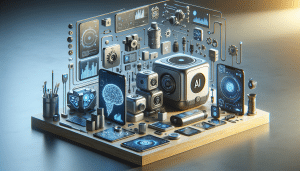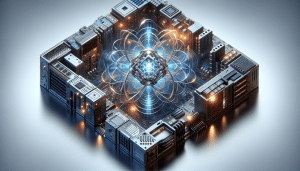Can Artificial Intelligence Learn Like You Do
Aiden Foster November 9, 2025
Explore how artificial intelligence adapts, learns, and evolves—revealing the surprising parallels between AI learning and human cognition. Delve into fascinating tech innovations and discover how machine learning shapes the technology around you.
Understanding How AI Absorbs Information
Artificial intelligence absorbs information through a process called machine learning. This approach allows systems to analyze massive amounts of data, identifying recurring patterns much like the human brain learns from repeated experiences. The machine learning model receives datasets, studies the details, and gradually makes predictions or decisions based on detected trends. These training sessions, repeated over time, help improve the AI’s performance. For instance, image-recognition software grows more accurate as it processes more photos, eventually distinguishing between animals, plants, or objects with remarkable accuracy.
Data acts as fuel for AI. Just as people need exposure and practice, artificial intelligence must be ‘fed’ new examples to enhance its problem-solving abilities. Developers use massive, structured databases—think millions of labeled photos or thousands of pages of medical records—to teach systems everything from speech recognition to disease detection. Ultimately, the volume and quality of the data set heavily influence how well the AI ‘learns’ and applies its knowledge. The richer and more diverse the training data, the more robust the results.
Unlike humans, AI does not instinctively know what to look for. Engineers often guide the process, setting goals and defining which characteristics are meaningful. These characteristics, called features, help the system focus during training. Over time, some advanced algorithms, such as deep learning, develop the ability to uncover hidden patterns independently. This approach mimics the human ability to learn and adapt with little intervention once a basic framework is in place.
Human Learning Versus Machine Learning
Both humans and AI seek to find patterns and solve problems. However, the ways in which information is processed differ greatly. While the human brain relies on emotion, instinct, and context, artificial intelligence focuses solely on the data provided. Human learning is flexible and influenced by culture, emotion, and creativity. In contrast, AI learning is bound to the logic of its algorithms and the structure of the datasets it processes.
Humans can leap to conclusions from very few examples—a phenomenon known as ‘one-shot learning.’ Children may recognize a new animal after encountering it just once. AI systems, by comparison, often require vast amounts of data to achieve a similar level of understanding. This difference is narrowing as research explores methods to help machines generalize from fewer examples, emulating human adaptability.
Feedback plays a vital role for both learners. People learn from mistakes, adjusting their actions in future situations. AI systems use a variant called ‘reinforcement learning.’ In this method, the system receives positive or negative feedback after each action, gradually steering its decision-making process toward higher success rates. Both approaches underline the importance of experience and correction in the learning journey.
Key Advances Driving Smarter AI Today
The stunning progress in artificial intelligence can be traced to three main advances. First, the explosion of big data gives machines much to learn from. Every time a person sends a message, uploads a photo, or uses GPS navigation, more real-world context is added to the digital pool. Second, improvements in computational power—such as powerful GPUs—enable AI systems to analyze complex patterns faster than ever before.
The third advance is conceptual: neural networks and deep learning algorithms. Inspired by the way human neurons fire and communicate, deep learning networks can process raw data through multiple layers, gradually extracting higher-level concepts. Technologies like natural language processing and advanced robotics rely on deep learning to make sense of spoken language, images, and even emotions.
These breakthroughs have made it possible for AI to learn tasks that were previously exclusive to people. For instance, AI-driven chatbots can answer customer questions almost instantly, while diagnostic software sometimes detects diseases in medical images earlier than human experts. These examples reveal the growing capacity for machines to synthesize knowledge—and continuously improve—using logic modeled after the human mind.
The Challenges of Teaching Artificial Intelligence
Training AI presents unique obstacles. Data bias is one significant concern: if the information fed into a system is incomplete or biased, the outcomes may be skewed or unfair. For example, a facial recognition system trained on limited types of faces may not perform well across diverse populations. This reinforces the need for vigilant oversight and continuous re-evaluation of data quality during the learning process.
Another challenge is transparency. Many machine learning models—especially deep neural networks—are described as ‘black boxes.’ They generate predictions or recommendations, but it can be hard even for developers to pinpoint exactly how those outcomes were determined. This complexity raises important questions about accountability, especially as AI takes on roles in healthcare, finance, and autonomous vehicles.
Lastly, AI demands significant computing power and energy. Training large-scale models requires specialized hardware and may consume more electricity than entire small towns. As society grows more reliant on artificial intelligence, it becomes crucial to address the environmental impact of data centers and seek energy-efficient solutions for building and operating smarter systems.
Ethical Considerations and AI’s Expanding Role
As artificial intelligence becomes more woven into daily routines, ethical questions intensify. Who is responsible if an AI-driven decision causes harm? How should privacy be managed when teaching systems with sensitive data? Thoughtful regulations and transparent practices are essential for balancing progress with safety and fairness.
Accountability and privacy aren’t the only concerns. AI can perpetuate, or even amplify, social inequalities if trained on biased or incomplete data. Researchers and developers work to identify and correct these issues by evaluating algorithms and data sources for potential disparities. The drive for ethical AI motivates the development of transparent, explainable models that can be audited for fairness.
AI is also a force for good, helping drive better diagnoses, create new artistic forms, and improve transportation scheduling. These benefits are maximized when ethics remain central to development. As machine learning algorithms become part of education, medicine, and commerce, prioritizing responsible design ensures that artificial intelligence strengthens society rather than dividing it.
The Future of AI Learning: Collaboration, Adaptation, and Limits
Looking ahead, artificial intelligence may become even more collaborative. Human and machine learning could intertwine, each compensating for the other’s weaknesses. Already, some projects use AI-assisted creativity—merging the best of human intuition with the depth of machine analysis. In other cases, people provide the ethical compass while machines handle complex calculations.
Continuous adaptation remains both a promise and a challenge. Tomorrow’s AI systems may not only learn new skills faster but may also understand context the way people do. There is hope that breakthroughs in transfer learning and self-supervised learning will enable AI to move beyond repetitive training, learning in more abstract, versatile ways.
Yet, there are limits. Machines remain dependent on the logic and resources provided by humans. Emotional nuance, true creativity, and moral judgment are still outside the reach of most systems. By remaining realistic about what AI can and cannot do, society makes space for technology to become a powerful partner—without losing sight of essential human strengths.
References
1. Russell, S., & Norvig, P. (2021). Artificial Intelligence: A Modern Approach. Retrieved from https://aima.cs.berkeley.edu/
2. Stanford University. (n.d.). Machine Learning. Retrieved from https://online.stanford.edu/courses/sohs-ymcml1-machine-learning
3. European Commission. (2020). Ethics guidelines for trustworthy AI. Retrieved from https://ec.europa.eu/futurium/en/ai-alliance-consultation/guidelines
4. University of Cambridge. (n.d.). Neural Networks and Deep Learning. Retrieved from https://www.cl.cam.ac.uk/teaching/1617/L126/
5. Harvard University. (n.d.). The black box problem in artificial intelligence. Retrieved from https://sitn.hms.harvard.edu/flash/2017/black-box-problem-artificial-intelligence/
6. Brookings Institution. (2023). Artificial Intelligence and Ethics. Retrieved from https://www.brookings.edu/research/artificial-intelligence-and-ethics/








